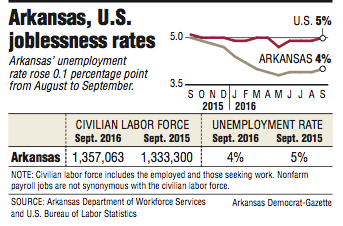Arkansas' unemployment rate rose one-tenth of a percentage point to 4 percent in September after five straight months below 4 percent, the U.S. Bureau of Labor Statistics said Friday.
The national unemployment rate was 5 percent in September.
The reason for the increase in the state rate from August was the addition of 1,513 Arkansans to the unemployment rolls, said Susan Price, a spokesman for the Arkansas Department of Workforce Services.
"We would expect to see the unemployment rate stabilizing at this point in time," said Kathy Deck, director of the Center for Business and Economic Research at the University of Arkansas at Fayetteville. "This is exactly where we think it should be."
The one-tenth of a percentage point increase isn't a cause for concern, Deck said.
The slight increase is well within the margin of error of 0.9 percent for the unemployment rate, according to the Bureau of Labor Statistics.
Even though the increase is not statistically significant, it is important because the unemployment rate seems to have entered a steady state, said Michael Pakko, chief economist at the Institute for Economic Advancement at the University of Arkansas at Little Rock.
"We've only seen movement of one or two-tenths of a percentage point plus or minus 4 [percent] over the past several months," Pakko said. "That's not surprising. It would be remarkable to see the unemployment rate fall significantly below 4 percent and I don't see the weakness in the economy to drive it significantly higher either in the near future."
The state unemployment rate dropped as low as 3.8 percent in May.
The number of Arkansans in the labor force grew by 23,763 since September last year, and the number of employed rose by 35,148. Since September last year, there are 11,385 fewer unemployed Arkansans, the bureau said.
"If we continue to see the labor force grow and we continue to see the unemployment rate remain about where it is, that means good things are happening on the employment side," Deck said.
Arkansas is far ahead of where it was a year ago from an unemployment perspective, Deck said.
In September last year, the state's unemployment rate was 5 percent.
Nonfarm payroll has grown by 14,200 jobs since September last year to 1,235,600. Nonfarm payroll jobs are not the same as the labor force. The two are calculated using different monthly surveys.
But the growth in payroll jobs does appear to be slowing, she said. The increase of 14,200 jobs since September last year is a 1.2 percent improvement, less than the rate of growth in previous months this year, Deck said.
Eight employment sectors added jobs in the past 12 months and three saw declines.
The educational and health services sector added the most jobs, 7,700 in the past year, to 185,000 jobs. The professional and business services sector grew by 3,900 jobs to 144,500.
The trade, transportation and utilities sector, which is the state's largest sector with 254,000 jobs, added 1,900 jobs since September.
"The good news about that is the sectors that are growing are ones that have a sizable share of the overall market," Pakko said
Construction jobs fell the most, dropping by 1,300 since September 2015 to 51,000. The mining and logging sector lost 1,200 jobs to 6,500, and manufacturing jobs fell by 700 to 154,100.
Three other sectors, though, added only 200 or fewer jobs -- government, which grew by 100 jobs in the past year; information, which added 200 jobs; and financial activities, which also added 200 jobs.
The private sector, which excludes government jobs, is growing at healthy rate of 1.7 percent compared with September last year, said John Shelnutt, administrator for economic analysis and tax research for the state's Department of Finance and Administration.
"The difference is that government has essentially no growth overall," Shelnutt said.
The state has been enjoying a long period of economic expansion since the recession ended in June 2009, Deck said.
"We still see a lot of strength across most sectors," Deck said. "The fact that we're getting a little bit slower growth than we have had may be just a deep breath."
South Dakota and New Hampshire each had the lowest unemployment rate in the country at 2.9 percent, followed by North Dakota at 3 percent, Nebraska at 3.2 percent and Hawaii and Vermont each at 3.3 percent.
Alaska had the highest unemployment rate at 6.9 percent, followed by New Mexico at 6.7 percent, Louisiana at 6.4 percent, Mississippi at 6 percent and Nevada and West Virginia at 5.8 percent each.
A Section on 10/22/2016
